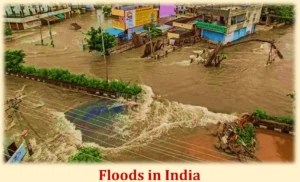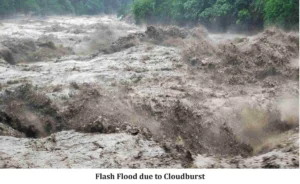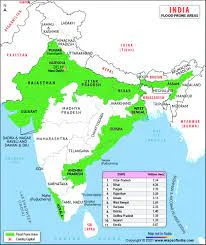
The monsoon season in India is a what everyone waits for, as it brings the promise of relief from sweltering heat. It rejuvenates nature with lush greenery and fills the air with a refreshing fragrance. The monsoon is undoubtedly a precious gift bestowed upon India by nature. It plays a pivotal role in nourishing the fertile lands, ensuring a bountiful harvest and quenching the thirst of rivers and lakes. But with great abundance comes great responsibility and this very nature’s bounty can turn into a challenge when the rains become excessive and relentless which results in landslides, floods in India etc.
In this blog, we will examine the flip side of the monsoon and understand how it poses challenges and risks to India and finally we will come up with few solutions to it.
Factors contributing excess water to the rivers
One of the most prominent threats posed by the monsoon is the occurrence of devastating floods. When the water level in a river exceeds, its carrying capacity due to excessive inflow from upstream or reduced outflow downstream, river overflow occurs. Factors like heavy rainfall, snowmelt, cyclones or siltation in the dams and barrages can contribute to river overflow. In 2023, the Yamuna River overflowed due to heavy rainfall in upstream states, causing flooding in several areas along the river. Let’s ponder upon few of these factors:
Heavy Rainfall
The monsoon season, stretching from June to September, brings intense and unpredictable rainfall to various parts of India. Sometimes, the rainfall surpasses the soil’s capacity to absorb or the drainage system’s ability to carry away the excess water leading to floods in India. This is what we have witnessed in Delhi, during the first half of July 2023. Delhi experienced more than the 209.7 mm of average rainfall leading to floods in several parts of the city.
Snowmelt
Melting snow and glaciers in the mountains flow into rivers and streams during rising temperatures. This increased water flow can cause floods downstream. Due to the ongoing global climate change this phenomenon has intensified.
Cyclones and Storms
Weather events like cyclones and storms can bring powerful winds and heavy rains along the coastal areas of India. These events can cause storm surges, sudden rises in sea level that inundate low-lying areas and lead to coastal flooding. Three districts of Rajasthan Jalore, Sirohi and Barmer were reeling under a flood-like situation due to heavy rainfall caused by cyclonic storm Biparjoy, as stated by the officials on June 18,2023.
Reasons for Floods in India
India’s struggle with floods can be attributed to various factors. One of the primary challenges is the country’s geographical diversity and topography. With different regions experiencing varied rainfall patterns it becomes challenging to have a one-size-fits-all approach to flood management. Few of these factors are:
Monsoon Variability
The monsoon season is a double-edged sword in India. While it brings much-needed rainfall for agriculture, its erratic patterns can lead to either droughts or excessive floods. Predicting the exact intensity and duration of monsoon rains is a complex task, making flood preparedness a daunting challenge.
Population Pressure and Urbanization
India’s rapidly growing population and increasing urbanization have contributed to encroachments on natural drainage systems and floodplains. This hampers the natural flow of water during heavy rains and exacerbates flooding in urban areas. The damages caused to the wetlands for urbanization have also added to the problem.
Lack of Sustainable Infrastructure
Another hurdle is the lack of sufficient and sustainable flood control infrastructure in some regions. Insufficient investment in dams, embankments and reservoirs can limit the country’s ability to manage floodwaters effectively.
Inadequate Disaster Preparedness
While India has made progress in disaster management and there is still room for improvement in terms of early warning systems, emergency response mechanisms and coordination among different agencies. Strengthening these aspects can save lives and minimize the damage caused by floods.
Climate Change Impact
Climate change is playing a role in altering weather patterns globally including in India. The changing climate is making the monsoon more unpredictable further complicating flood management efforts.
Socio-economic Challenges
Socio-economic factors such as poverty and inadequate infrastructure in rural areas make it challenging for vulnerable communities to cope with floods effectively. They are often hit the hardest during floods and struggle to recover from the losses.
Impacts of the Menace
Damage to Land of Living
Loss of Life
Floods can be deadly, causing fatalities through drowning, injuries, infections and many more. On average, about 1,600 lives are lost due to floods in India every year. In 2023 alone, at least 60 deaths were confirmed across North India due to floods.
Displacement of People
Floods force people to leave their homes and seek shelter elsewhere, disrupting their lives and livelihoods. In 2020, floods displaced about 5.4 million people in India. In 2023, thousands of people in North India, particularly in Himachal Pradesh and Punjab were displaced due to floods.
Damage to personal Property
Floods damage or destroy houses, infrastructure, crops, livestock, and assets. The estimated annual damage worth ₹ 1,805 crore is inflicted on crops, houses and public utilities due to floods. In 2023, floods have caused extensive damage to landmark in Delhi, such as the Red Fort and the Supreme Court.

Environmental Degradation
Floods negatively impact the environment, eroding soil, altering natural habitats, polluting water sources and increasing the risk of landslides and epidemics. The ecological balance of rivers and wetlands is also affected posing a threat to endangered species such as the Gangetic dolphin and the gharial in the Yamuna River.
Economic Losses
Floods can hinder economic growth and development by reducing agricultural output, disrupting industrial production, affecting trade and commerce and increasing expenditure on relief and rehabilitation. The tourism sector is also impacted by flood-induced damage to cultural heritage and natural attractions amounting to an annual cost of about $14 billion for India. In 2023, north India floods and alone caused an economic loss of ₹ 10000-15000 crores. This not only acts as a barrier in the country’s development but also takes us a step back.
Multi-faceted Solution
Addressing the issue of floods in India requires a multi-faceted approach that considers all these challenges. Investment in sustainable flood control infrastructure, community-based preparedness, early warning systems and improved urban planning are some of the key steps that can help India move towards better flood management.
Sustainable flood control Infrastructural developments
Embankments
Embankments are raised structures that contain the flow of water within a channel or along a bank. They act as protective barriers, increasing the river’s carrying capacity and diverting excess water to safer areas. The Kosi embankment project in Bihar stands as a testament to flood prevention and enhancing the riverfront.
Storage Reservoirs
Artificial storage reservoirs play a crucial role in flood management. They store excess water during high-flow periods and release it during low-flow periods. By doing so, they help in moderating flood peaks and reducing the volume and velocity of water downstream. Additionally, these reservoirs serve multiple purposes like water conservation for irrigation, electricity generation and water supply. The Bhakra Nangal Dam with its impressive storage capacity serves as an excellent example of flood control and resource utilization.
Community-based preparedness and early warning systems
Flood Forecasting and Warning System
An essential aspect of flood management is a reliable flood forecasting and warning system. It provides valuable prior estimates of approaching floods helping in timely evacuation and protecting lives and movable assets. This was what seen in mid of June when Cylone Biparjoy was about to hit Gujarat. IMD issues early warning which helped in saving many lives. Moreover, it aids in reservoir operation and coordination during flood relief efforts. The Central Water Commission’s extensive network of flood forecasting stations across India keeps the nation informed and prepared during flood situations.
Flood Plain Zoning
Regulatory measures like flood plain zoning are instrumental in minimizing the exposure and damage to human settlements and infrastructure. By restricting or regulating land use in flood-prone areas based on vulnerability and suitability we can discourage development in high-risk zones. This approach also promotes the conservation of natural flood buffers like wetlands and forests. The NDMA’s guidelines for flood plain zoning classify land into different zones ensuring a safer and sustainable environment.

Flood Awareness and Education
Building a culture of safety and resilience requires proactive social measures such as flood awareness and education. Creating awareness among stakeholders like communities, officials, media and NGOs empowers them with knowledge about flood hazards, mitigation measures, early warning systems and emergency contacts. The NDMA’s various awareness campaigns and training programs play a vital role in fostering a prepared and informed populace.
Learning and Progress
It’s important to remember that overcoming such a complex issue takes time and continuous learning. India is continually striving to enhance its flood management strategies by learning from past experiences and collaborating with international experts. Our leaders can learn from countries like China that have successfully handled the problem of flood.
Effective flood management in India requires a multi-pronged approach, incorporating both structural and non-structural measures. By leveraging the power of reservoirs and embankments alongside flood forecasting, zoning, awareness and education. We can navigate the waters of floods with resilience and determination. Embracing these solutions we can protect our communities, resources and environment ensuring a safer and more sustainable future for all.

Thank you 🙏
Very helpful sir🙌
Very informative 🙏
Well written 👏
बहुत जानकारीपूर्ण 🙏
Very informative article 👌👌👌👌
Thank you 🙏
Well explained
👌👌👍